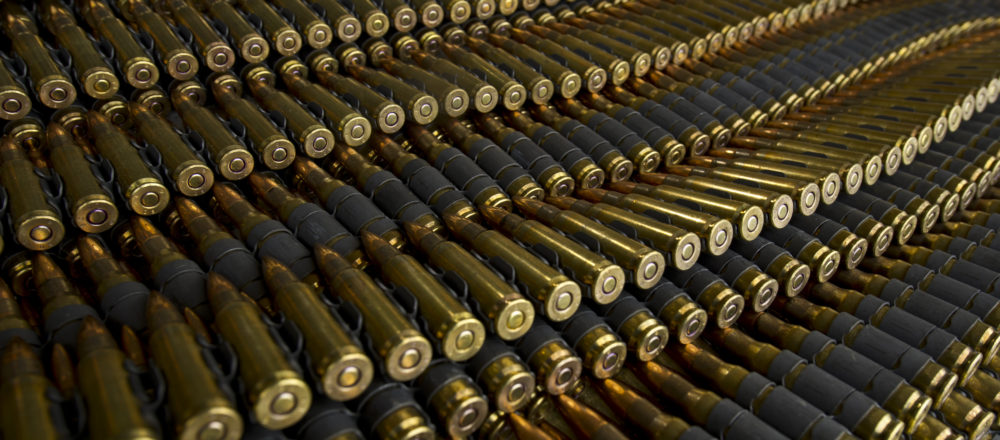Armed violence kills more than half a million people each year, small arms being responsible for a great proportion of these deaths. As Stephanie Koorey recently noted in Inside Story, while small arms and other conventional weapons do not cause wars, they do contribute to the “outbreak, intensity and duration of conflict”. As a consequence, the poorly regulated trade in international arms is a contributing factor to many problems relating to international peace and security.
Whether the newly adopted Arms Trade Treaty (ATT), which was overwhelming approved in the UN General Assembly on 2 April, will be able to successfully eliminate or prevent the harms associated with the international arms trade, however, is uncertain. Without unequivocal support for a regulated international arms market that holds countries to the highest standards, the treaty may not achieve its purpose.
In 2009 the UN General Assembly (UNGA) tasked the international community to create a “legally binding instrument on the highest possible common international standards for the transfer of conventional arms”. A global ATT must be “strong and robust” in order for it to be effective, said the Assembly, and it recognised that the “unregulated trade of conventional arms and their diversion to the illicit market” are contributory factors to innumerable problems relating to international peace and security, including armed conflict, the displacement of people, organised crime and terrorism, and the undermining of sustainable social and economic development. The job at hand was to devise an ATT that would work to prevent these problems.
The ATT seeks to establish common international standards for the import, export and transfer of conventional arms. Ideally the treaty would prevent the misuse of conventional arms and their diversion to illicit markets, as well as ensure arms are not transferred if there is a substantial risk they would be used to violate international humanitarian or international human rights law, or be used in the commission of terrorism. The wars in Libya and Syria that broke out in 2011 demonstrated the harms that can arise with arms transfers, including the misuse of conventional weapons by government forces, often against their own citizens, as well as arms diversion.
To take an example, it is becoming well-documented that weapons shipped to Muammar Gaddafi’s government in Libya in 2009 by Belgium’s principal small arms manufacturer, FN Herstal, are currently circulating in Libya and possibly elsewhere in West and East Africa, fuelling regional conflicts. The weapons were sold to equip Gaddafi’s 32nd Brigade, a unit that, according to a report of the United Nations International Commission of Inquiry on Human Rights in Libya, has been linked to torture and other inhumane and degrading treatment, as well as the indiscriminate shelling and murder of civilians. Following the collapse of the Gaddafi regime, Libya has seen a spike in weapons proliferation, as arms that have seen their days in the Libyan uprising are being sold on the black market to foreign militias.
Representatives from Mali recently told the UN Security Council that the Libyan crisis has aggravated arms trafficking in Mali and threatens to undermine the already fragile stability in the region. Mali, a landlocked country in West Africa bordered by Algeria to its north, has been embroiled in violent conflict in its northern region since January this year. Weapons diversion can have a far reach. Assault rifles, of the same kind that were shipped to Libya in 2009, have recently been spotted in the hands of the armed wing of the Palestinian Islamic Jihad in the Gaza Strip, a group designated a terrorist organisation by the United States and Australia. A theory is that these weapons were diverted to Gaza from Libya, though it is so far impossible to trace the weapons’ origins and know for sure.
There are also concerns that Belgian, and other Western-made weapons, could end up in the ongoing conflict in Syria, which has already claimed over 70,000 lives, according to UN estimates.
By setting global standards for weapons transfers, an ATT will have a range of humanitarian benefits – including the reduction of interstate arms diversion, armed conflict and deaths due to armed violence.
There has been strong support for a robust treaty among the majority of states. Despite this year’s final UN conference on the ATT failing to achieve the consensus required to adopt the treaty, ultimately when it was put to a vote in the UNGA on 2 April, the ATT was approved with 155 votes in favour, 22 abstentions and only 3 against. The wait now is for the ATT to get the 50 signatories required for it to enter into force.
The failure to reach consensus during the conference however is significant, particularly as it was the second time the treaty process was stalled. On the final day of negotiations in March, North Korea, Syria and Iran objected to adopting the final draft put forward by Conference President, Ambassador Peter Woolcott. Similarly, during the UN conference on the ATT last year, the United States, Russia and China announced on the last day of negotiations that they needed more time to consider the text of the draft treaty, thereby delaying the process until negotiations resumed this year.
The dynamics at work behind disagreement over the treaty are inherently political. Iran and Syria condemned the proposed treaty, both saying it contained flaws, including that it does not prohibit weapons transfers to rebel groups and groups that commit “acts of aggression”. Given the Arab League recently defended the right to arm Syrian rebels, Iran and Syria’s criticism is unsurprising. The Syrian Government, which has been accused of rights abuses in its conduct of the 2011 civil war, also relies on arms imports from Iran and Russia. Russia, a close ally to the Assad Government, did not block the treaty but expressed its concern over the treaty’s failure to achieve the required consensus.
More broadly, differences exist between states that advocate for a robust treaty that has concern for human rights and humanitarian issues at its core, and those that stress the right of sovereign states to engage in arms trade for commercial and strategic reasons.
In a joint statement released on 18 March, leading exporting countries the United States, Russia, China, France and the United Kingdom emphasised that while they support an ATT, the authorisation or denial of any international conventional arms transfer must be “the sole responsibility and right of the sovereign state”, and the treaty must not “hinder the legitimate arms trade or the legitimate right to self-defence under the UN Charter”.
By contrast, Ghana also delivered a joint statement on behalf of over 100 countries during the conference, arguing for a robust ATT that is free of loopholes. The statement advocated incorporating ammunition, long a sticking point in treaty negotiations, fully into the scope of the treaty, along with other important improvements. It is revealing that big arms exporters the United States, Russia and China did not endorse Ghana’s statement. It is also likely not an accident that many of the countries that signed Ghana’s joint statement arguing for a loophole-free ATT are states, largely from the developing world, which have experienced armed conflict first-hand.
The adoption of the ATT is a significant step forward. For the first time there will be common international standards for the transfer of arms and exporters will need to confirm that weapons will not be used to commit serious violations of international human rights or international humanitarian law, including genocide, crimes against humanity and other war crimes.
However the ATT contains weaknesses. The joint statement delivered by Ghana rightly points to loopholes within the treaty that may undermine the objectives of the treaty itself.
The treaty does not include ammunitions, munitions and parts and components under its scope; rather they are addressed under separate articles. As a result these are subject to weaker controls than those conventional weapons, such as battle tanks, attack helicopters, and small arms and light weapons, which are listed under the treaty’s scope. This is problematic because weapons can last for decades, provided they have access to ammunition and parts to keep them functional. Ammunitions and parts need to be treated as seriously as weapons themselves.
It is also troubling that the treaty does not include non-commercial transfers – which could include gifting, loans and leases of arms – in its definition of what constitutes a transfer or trade. This means states could donate or lend weapons to other countries despite a risk that they would be used to commit serious human rights violations.
The ATT also says that there must be an “overriding risk” of violations of international human rights or international humanitarian law before a transfer is denied. This risk threshold has been criticised by states and rights groups, with Oxfam International labelling it as “confusing and potentially dangerous”. According to Oxfam, the term “overriding” raises the prospect of exporters being able to argue, for example, that an arms transfer will have security benefits for the importing country that outweighs, or “overrides”, any risks of humanitarian harm that is likely occur as a result of the transfer. The threshold of a “substantial risk” has been consistently put forward as an alternative that better conforms with international human rights standards.
Another big loophole is that international arms transfers made as part of defence cooperation agreements are exempt from the treaty. This means states could transfer arms despite risks of weapons misuse. An example might be Russia citing its defence contracts with Syria to justify the export of weapons to the Assad Government. Such a circumstance would run counter to the humanitarian purpose of the ATT.
The treaty’s shortcomings listed above are not exhaustive, but there are also factors to consider that are outside the remit of a treaty. Addressing the demand for weapons and ammunition is also necessary to combat the harms associated with armed conflict. However, it is a difficult task to curtail the reasons why states, individuals or non-state groups weaponise and engage in conflict in the first place.
The ATT is a significant step forward in regulating international arms transfers and curbing global arms proliferation and armed conflict. But it is the responsibility of states to implement the measures mandated by the treaty; the actions of the world’s biggest exporters, in particular, are important. The United States, for example, is the word’s largest gun exporter, accounting for 30 per cent of global volume. But the US Administration faces a tough fight against US Senators who contend the treaty could affect American gun ownership rights – a claim, by the way, which is baseless.
Australia is well placed to be an exemplary nation when it comes to upholding the highest standards in international arms trade. Australia’s arms export standards are already of high quality, and Australia has persistently backed the adoption of a global ATT. Not to mention that our weapons imports and exports are a drop in the sea by global standards; for the period of 2006 – 2010 Australia was ranked only the 26th largest arms exporter in the world.
If America and other big exporters do not ratify and uphold the principles the treaty, though, it is difficult to imagine how effective the ATT can be. There needs to be unequivocal support from most, if not all states, for a regulated international arms market that holds countries to the highest standards. Without this, the treaty will not have force.
The adoption of the ATT is an historic first step, but the work to limit global armed violence is just beginning.



